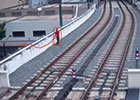

Each industry is guilty of creating terminology that may, or may not, add value to the end-user’s understanding of what the product does. In perimeter video security, one such term is the video edge device. On its own, the term is not that descriptive. It obviously has something to do with video, is either very thin or it is physically not located in the centre. All educated guesses, but let’s take a quick look at video edge devices … what are they and when might you use one for your remote facility?
What is a video edge device?
Although an edge device may indeed be small, and perhaps thin, the name piggybacks on the use of the same name in the IT world. It is essentially a device that moves traditionally centralised video tasks away from the video surveillance command centre and towards the ‘edge,’ which in our case refers to pump stations, inlets, cell towers, generating stations, microwave links, transfer stations or any other type of unmanned, or temporarily manned location. Most edge devices are small compact computers and somewhat rugged in nature.
As the definition implies, you can think of an edge device as a full blown command and control/video management system. It likely contains the capability to perform all the same tasks that an enterprise level video management can perform. The difference is that it is serving a much smaller site. So a smaller number of sensors or a smaller physical area, with the idea that it may take action and report data differently, given this reduced set of responsibilities. Video edge devices can record video, detect intrusions, control cameras, create alarms, activate remote devices, retrieve data and communicate status. The key to an edge device is that it plays a defined role in order to defer processing responsibilities from a central system. So what are some of the key roles for which these devices are used?
What functions do video edge devices perform?
Challenging environments – The first use of edge devices, and still a common use today, was merely environmental. Often, remote facilities are environmentally challenging. Edge devices typically come in a variety of ruggedised flavours to perform in extreme environments, such as, temperature extremes, high humidity, wet locations or sites with limited power or connectivity. This in turn drove the compactness factor, keeping the cost of ruggedising a unit to only the size needed to perform the operations at that remote location.

Bandwidth management – Remote locations often mean poor or limited communications. A common role of edge devices is to manage the communication pipe to ensure that important information is prioritised or buffered until it can be received. Edge devices can typically operate in lower resolution mode, on-demand only or just alarm mode. Some may normally operate in a low resolution mode, but replace the low resolution data with locally stored high resolution files as bandwidth becomes available in off hours. With the advent of very high resolution cameras, the need for this type of bandwidth management has become more prevalent.
Distributed storage – Related to bandwidth management is the strategy to use the edge device to distribute the storage of video data. There may be many reasons to do this from a security/data backup perspective, but from a practical standpoint, the central monitoring location is most likely only interested in the 15 minutes of footage showing the actual break in. The 23 hours and 45 minutes of video of blowing leaves and cloud formations may not warrant transmission over the site’s data link. This data is not lost, but remains at the remote location until such time that it is needed, or groomed from the device.
Increased automation – By their very nature, unmanned, remote sites are …. unmanned and remote. So when an event does occur, it becomes a logistical challenge to react to the event in an effective or timely manner. Today’s edge devices are expertly designed to accommodate a higher level of integration and intelligence to perform much of the leg work for you. These devices can detect events, collect pertinent data and take proactive steps to deter a situation.

A typical example might be a vandal at a communications tower. An edge device could use a fixed camera to detect that the movement in the camera was a person and that they had come within a designated distance to the facility. The device could then take control of a PTZ camera and lock on to the target for continuous following. This alone could provide video evidence to either verify the safety of the location was not compromised or to aid in the apprehension and prosecution of the individual. Better yet, many of these devices have the intelligence to actually take deterrent actions, by invoking situationally based audio commands or tracking the target with directional spotlights. This type of automation typically requires quick reaction time from controlled sensors, which would not be available over a bandwidth limited, or intermittent, data line. These automated actions can either deter the event, or minimise its impact.
When to consider using an edge device
The decision to use one can vary greatly based on the situation and characteristics of your remote site. Luckily, edge devices are affordable and designed to integrate into existing video infrastructure. This makes the decision to use such a device a little easier to manage. Some common reasons to consider using an edge device include:
Critical locations: If you have a site that is critical in nature, but cannot be manned, or is very remote, the automation available in today’s edge devices can be invaluable in either deterring a situation, or providing evidence that a site is secure after an event. Target classification, behaviour recognition, automated camera following and intelligent audio talk down are common features in today’s edge device and can be very helpful in the protection of these types of critical locations.
Budget constrained need for advanced capability: As mentioned earlier, edge devices typically include all the capabilities of an enterprise level video management system, but only for a limited number of inputs. So if you desire some of the latest technology features, but aren’t in a position to upgrade your entire security system, a video edge device is an excellent, low cost way, to introduce these features to a specific site or problem area. This approach allows you to understand the capabilities of the device in a localised setting before expanding it to the rest of your operations.
Ageing infrastructure: Locations with low bandwidth communication links, intermittent links or no means of communication are good candidates for edge devices. The ability to manage the use of the limited data lines allows effective monitoring of these types of sites without an expensive communications infrastructure upgrade. Even if you have a good communication infrastructure, but want to explore the use of bandwidth intensive devices, such as high resolution cameras, edge devices can provide a means to bring these devices into your system without impacting your current network loading.
Mobile or temporary installations: Mobile or temporary locations are a great opportunity to use a video edge device. These sites often have unique requirements and may involve purchase of new equipment. Based on the situation, they may be standalone, or require integration with your main video management system, which is exactly the role an edge device fulfils. It is also a great way to get exposure to the device’s capability and determine in what other fashion it may provide value in your overall video security infrastructure.
Although the name may be somewhat ambiguous at first, video edge devices can be a valuable addition to your video arsenal. They also provide an affordable path to introduce capability into your existing system. Remote sites encounter a variety of constraints and issues when ensuring their safety and integrity. Understanding the capability of an edge device can aid in addressing these issues.
For more information, contact Eric Olson, PureTech Systems, +1 602 424 9842, eric.olson@puretechsystems.com, www.puretechsystems.com

© Technews Publishing (Pty) Ltd. | All Rights Reserved.